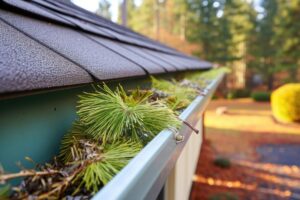The fires that burned hundreds of homes around Los Angeles recently were yet another stark reminder that wildfire risks driven by drought and wind are increasing.
Nothing can guarantee a home will survive a massive wildfire in high winds.
But fire research has shown several factors can dramatically improve a home’s chances of surviving.
Photos from recent wildfires in California, Colorado, and Hawaii show homes that survived while ones next to them burned. Green trees sometimes are still standing next to the destroyed houses, which seems impossible.
It’s a phenomena Hank Blackwell, interim director of the Wildfire Resiliency Training Center at Luna Community College is helping people understand. Blackwell, an experienced fire manager and fire researcher, wants people to understand what increases the wildfire risks to houses.
“We’re basically trying to change paradigms,” he said. “What’s really igniting homes? What’s the fire science behind it and what can homeowners do?
Blackwell is teaching a free structural ignition workshop in Bernal on Saturday, Feb. 7. It is the sixth such workshop in San Miguel and Mora counties, coordinated by Luna Community College and the New Mexico Forest and Watershed Restoration Institute.
To register for the Feb. 7, Structural Ignition Workshop in Bernal, contact Ellen Drew by phone or text at 505-652-9439 or by email: drewnm@gmail.com
According to the National Fire Protection Association, research over the last couple of decades found that embers cause the majority of homes to burn in wildfires. Those embers find flammable materials to land on and then make their way into structures. During a wildfire, winds can blow embers a mile or more away from the main body of the flames, creating new spot fires. Unscreened vents, wood piles or wood fences touching house walls, weeds under porches and lawn furniture on top, can all act as kindling for a wildfire.
Reducing wildfire risks to homes and other structures is simple and isn’t expensive.
 NFPA recommends homeowners take the following actions within five feet of a house or other structures. That is the area most vulnerable to a fire started from embers.
NFPA recommends homeowners take the following actions within five feet of a house or other structures. That is the area most vulnerable to a fire started from embers.
- Clean debris, leaves and pine needles from roofs and gutters.
- Install fine metal mesh screening behind vents in the eaves to prevent embers from entering.
- Install metal mesh screening around the bottom of porches and decks to prevent embers from entering underneath.
- Repair or replace window screens
- Remove anything flammable away from exterior house walls such as leaves, pine needles, wood piles, construction materials, etc.
